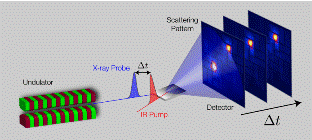Department of Physics and Astronomy: Publications and Other Research

Matthias Fuchs Publications
Document Type
Article
Date of this Version
2009
Citation
Published in Nature Physics 5 (2009), pp. 826–829; doi: 10.1038/nphys1404.
Abstract
Synchrotrons and free-electron lasers are the most powerful sources of X-ray radiation. They constitute invaluable tools for a broad range of research1; however, their dependence on large-scale radiofrequency electron accelerators means that only a few of these sources exist worldwide. Laser-driven plasma-wave accelerators2–10 provide markedly increased accelerating fields and hence offer the potential to shrink the size and cost of these X-ray sources to the university-laboratory scale. Here, we demonstrate the generation of soft-X-ray undulator radiation with laser-plasma-accelerated electron beams. The well-collimated beams deliver soft-X-ray pulses with an expected pulse duration of ~10 fs (inferred from plasma-accelerator physics). Our source draws on a 30-cm-long undulator11 and a 1.5-cm-long accelerator delivering stable electron beams10 with energies of ~210 MeV. The spectrum of the generated undulator radiation typically consists of a main peak centred at a wavelength of ~18 nm (fundamental), a second peak near ~9 nm (second harmonic) and a high-energy cutoff at ~7 nm. Magnetic quadrupole lenses11 ensure efficient electron-beam transport and demonstrate an enabling technology for reproducible generation of tunable undulator radiation. The source is scalable to shorter wavelengths by increasing the electron energy. Our results open the prospect of tunable, brilliant, ultrashort-pulsed X-ray sources for small-scale laboratories.


Comments
Copyright 2009 Macmillan Publishers Limited. Used by permission.